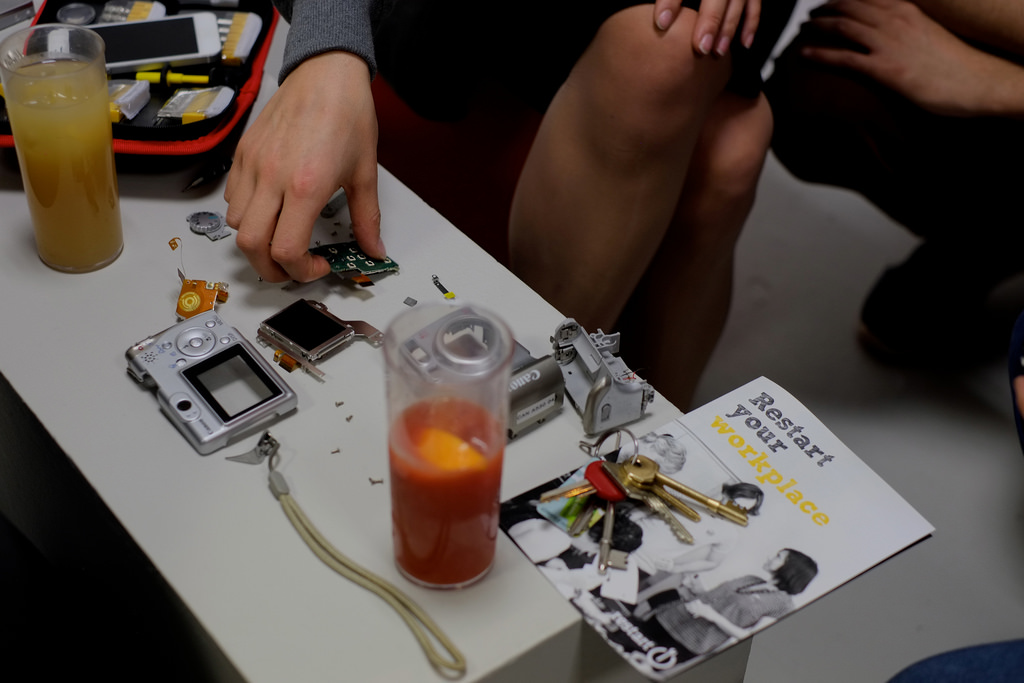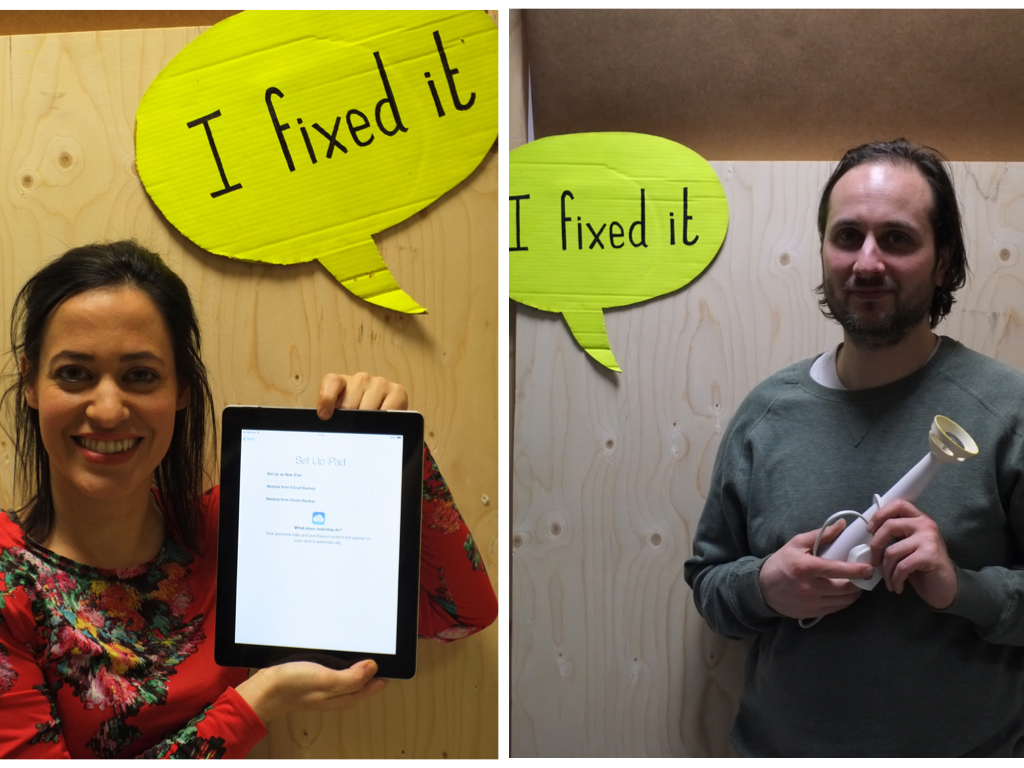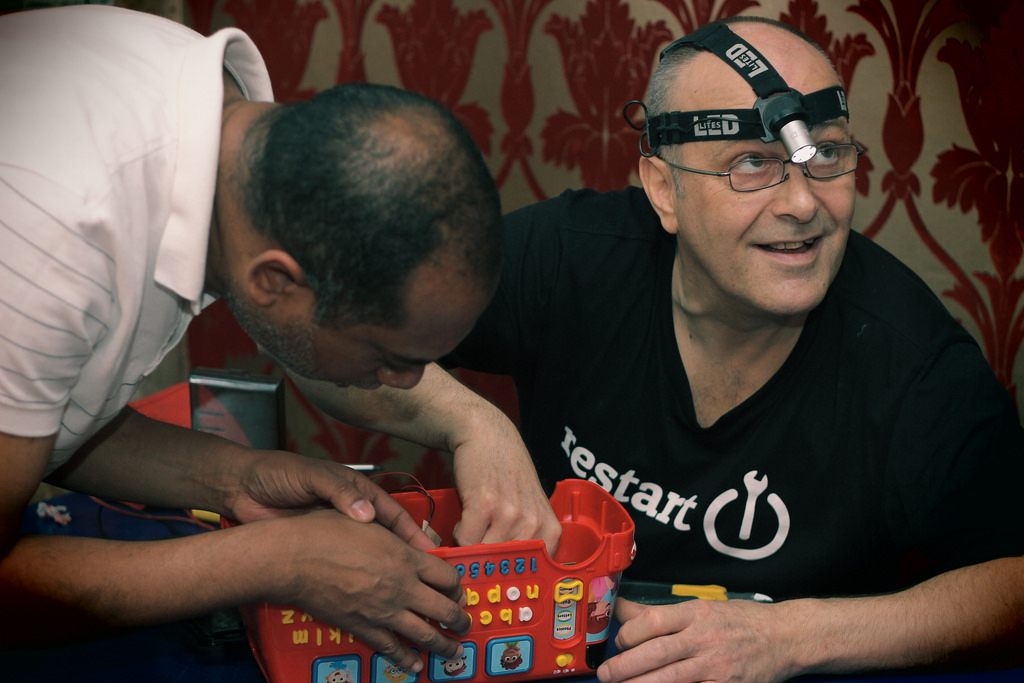
Curing upgrade fever the Restart Project way. Image by RestartProject (CC BY-NC 2.0).
This is the story of how I rescued my love for communication technology literally by rolling up my sleeves.
Ever since my dad brought home an Apple Macintosh—one of the earliest models—I've been a keen user of technology. My brother and I used MacPaint and printed out our artworks on a dot matrix printer. Then came page design, and then came blogging. I started my first blog in 2001, in East Timor, a new country “at the end of the world”. I worked on an old PowerBook, transferring blog posts via floppy disk to a computer at my workplace, which had a satellite connection to the outside world.
Blogging for me was much like making a fanzine [1]. What I loved about it wasn’t so much the “many to many” aspect, but the “many to few”. I loved writing for the 12 people in the world who cared about the same obscure topics I did. It was a powerful way of connecting, all made possible by computers and the Internet, neither of which I took for granted.
Later, Twitter arrived, and I got sucked in. Then I quit my day job and became a self-employed slave to a smartphone, constantly frustrated by the device, and feeling the pressure to upgrade with each new model. My day job, at an international development NGO, had already sensitized me to the absurd way in which we in Europe and North America devour and discard gadgets. I'd worked for years with people in Asia, Latin America and Africa who made the most of everything they had, carefully maintaining and refurbishing their equipment. Then I would return home and see the same people who refused plastic bags at the farmers’ market upgrading their mobile phones every nine months.
I began to feel a growing disquiet with the tools that afforded me such joy, such a feeling of connection with friends, family and like-minded strangers across the world. After decades of loving technology, I felt compelled to do something to change my own behavior, and test how many people wanted to join me in doing the same.
My friend Ugo Vallauri and I started hosting “Restart Parties” in London, events that brought together talented electronics tinkerers and fixers, and frustrated owners of electronics. The idea was not to provide a free repair service, but rather to empower owners of devices to open up their gadgets, learn how they worked and have a go at fixing them. In the process, people would learn how to buy for longevity and be smarter users of technology.
In two years, we’ve run over 55 events in pubs, churches, galleries and community centers, saving an estimated 895 kilograms from waste. More importantly, we’ve uncovered a huge potential for change at the grassroots level, not led by any government, “green” company or mega-NGO.

A tablet and a hand blender get a new lease on life at a “Restart Party” in London, UK. Image by RestartProject (CC BY-NC 2.0).
Our inspiration for acting came from the same place as our blogging, and interest in living and working abroad. In fact, a key inspiration was contact with vibrant repair and reuse cultures in places like Kenya and Brazil, where professionals still make money fixing all kinds of devices.
A more subconscious influence was the Brazilian “mutirão”, a collective of people who each offer what they can to a group effort. (The word can be traced to the Guaraní word motirô, although its historical etymology remains obscure.) The mutirão is characterized by its loose structure. Leadership, such as any exists, is fluid and not institutionalized. Often, a mutirão would be called upon to deal with an immediate, shared problem, like painting a wall or cleaning a drain, or building houses or schools.
Another, more explicit, influence [2] is Brazilian scholar and activist Paulo Freire [3], and his emphasis on transformative, dialogic learning.
Today we have friends in five countries remixing our idea and jump-starting their own communities of people engaged in electronics repair. Contacts in ten more countries are keen to host their own “Restart Parties”. This burst of bottom-up activity was made possible by the power of the social internet, as we have been sharing every step of our journey online [4]. A big part of this involves releasing our materials, such as photos [5] and how-to documents, under a Creative Commons [6] license.
Electronics repair communities are only the beginning for us: our mission is to fix our relationship with electronics. We would like to do more to link with commercial repairers, testing new business models for electronics repair and reuse, as well as work with teachers, children and parents to promote a critical consciousness. We also have in mind sharing more disruptive, guerrilla-style projects. And we’ll be sharing every step of the way.

Bringing a toy bus back to life at a “Restart Party” in Brixton, London, UK. Image by RestartProject (CC BY-NC 2.0).